At Les Jardins de la Grelinette, we’ve been growing vegetables commercially with hand tools (i.e. without a tractor) for more than a decade and if efficiency and yields are to be the measure for successful growing, our tools and techniques have proven to be just that: incredibly productive.
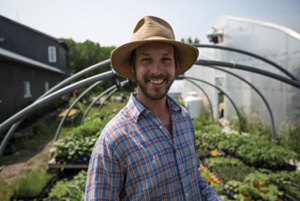
Recently our friends at FarmStart, an organization dedicated to supporting new ecological farmers, asked us to provide them with a list of our six favorite market gardening tools. This is not an easy task given that all of our tools complement one another in our intensively cultivated 1.5 acres. It’s like asking which part of your car you think makes it run properly. Nonetheless, here is our ranking.
Rotary Power Harrow
We began working with a power harrow, which is mounted on our BCS walking tractor, in order to replace the rear tine tiller that usually comes equipped on walking tractors. The power harrow has multiple sets of tines that rotate on a vertical axis for complete horizontal tilling of the soil. It works the soil by stirring it instead of mixing it, as a tiller would do. The result is soil layers that are not inversed (there are may benefits to this) and no vertical compression of the soil, which can lead to hardpan formation.
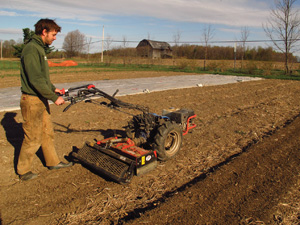 Jean-Martin Fortier with the rotary power harrow on his Quebec farm.
Jean-Martin Fortier with the rotary power harrow on his Quebec farm.
The power harrow is equipped with a steel mesh roller in the rear that perfectly levels and pre-tamps the soil for good seed-to-soil contact. You can easily and quickly adjust the working depth of the tines to cultivate only the top few inches. This feature is important for us since it allows us to work the soil to a depth of no more than 2 inches, in accordance with minimum tillage techniques we favor on our farm.
One pass with the power harrow gives us a perfectly conditioned bed ready for transplants and direct-seeded crops. Overall, it’s far superior to a rototiller and I would recommend trying it first before adopting another tilling or spading device. It’s also worth mentioning that the better ones are built by Rinaldi R2 which is compatible with BCS, Ferrari, and Pasquali walking tractors.
Berta Plow
We grow on permanent raised beds and overall we have 180 of them, each 100 feet long. When we started the farm, we dug all of them with shovels and I still remember how long of a job that was. Nowadays, we use a Berta Plow (also mounted on our BCS walking tractor) to do the same, only 50 times faster. Raised beds have a tendency to settle over time, so we continually have to hill the soil. The Berta Plow takes the soil from the bottom and moves it sideways. Due to the fact that the soil is not trapped under a hood and repeatedly pulverized, as would happen with a tiller, the soil structure is not beat to death. The Berta Plow is also great for breaking new ground, making it, I believe, a more that worthwhile investment when starting out the market garden.
Flame Weeder
We haven’t hand-weeded a carrot bed for many years now thanks to the help of this amazing gizmo. We rely on flame weeding mostly for burning weeds in the pre-emergence stage of slow germinating, direct-seeded crops such as carrots, beets and parsnips. This approach is somewhat like the false seedbed technique, where seedbeds are prepared two weeks before planting (to give the weeds a head start), but instead of destroying the emerged weeds prior to seeding, you seed the bed one week earlier halfway into the process. Just before your vegetable seeds emerge from the soil, you run the flame weeder over the ground, leaving the crop to emerge into a weed-free bed. Simple and VERY effective. If you’re still pulling weeds on your hands and knees, you should definitely look into getting this time-saving tool.
Effective thermal weed control depends on thequality of the flame weeder. Ours is 30 inches wide and features five torches, which allows burning at a high intensity with multiple flames. The torches are shielded from the wind by a metal hood—an important feature that allows us to use the tool in windy weather.
 A five-torch flame weeder is used to kill weed seedlings just before carrots emerge.
A five-torch flame weeder is used to kill weed seedlings just before carrots emerge.
Crop planning calendar
Granted, a calendar is not a piece of equipment, but it’s so vital to our market gardening success that I could not go without giving it a place in this ranking. On our farm, everything we do, what we grow, when we start our crops and where we seed everything is all pre-determined in the winter and laid out as a cropping guideline for us to follow. Come summertime, when things get crazy, this a precious asset and if done properly, a calendar of this sort leaves nothing to chance. We are able to grow the equivalent of about 250 CSA shares on our 1.5 acres mainly because we have many successions following one another. Without our crop-planning calendar, this simply would not be feasible.
UV-Treated Polyethylene Tarps
The main factor in keeping a garden weed-free is how much space is to be kept under control. If we had to cultivate the whole 1 ½ acre garden every week to keep it clean using hoes, I doubt we would manage. This is where black plastic mulch comes in handy. Covering unused beds with tarps is a very effective way of avoiding weed proliferation in the garden AND diminishing weed pressure on subsequent crops. The explanation is simple: weeds germinate in the warm, moist conditions created by the tarp but are then killed by the absence of light. This weeding technique, called occultation, is widely use by organic growers in Europe.
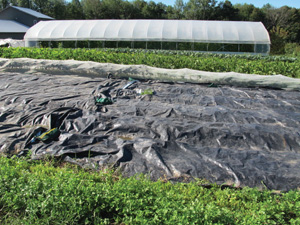 The author favors UV-stabilized tarps to smother weeds and kill crop debris. In France, this technique is called occultation.
The author favors UV-stabilized tarps to smother weeds and kill crop debris. In France, this technique is called occultation.
I believe plastic tarps are just as beneficial to soil as other forms of mulching. We are often reminded of this when we pull back a tarp and are greeted by an abundance of earthworms.
The Quick Cut Harvester
Mesclun is our signature crop and we’ve been growing thousands of pounds annually for a long time. Over the course of that time, we’ve pretty much tried every possible growing technique to lessen the burden of this labor-intensive crop. By far, our biggest advance was the purchase of the quick cut harvester—a mechanical greens harvester powered by a hand drill that saves us hundreds of harvesting hours yearly. I wrote about it in a previous GFM article and its designer has made important improvements to the tool since them. You can see a great short video of the product featuring Eliot Coleman here: http://www.youtube.com/watch?v=OPIfw5_WoLUY
Stopping at six favorite tools is almost torment. How can I not mention the broadfork, the collinear and wheel hoes, our vacuum and precision seeders, or the paperpot transplanter, which we are trying to hack to make more effective and affordable?
You’ll find all the details of our farming system in my recently published book, The Market Gardener: A Successful Grower’s Handbook for Small-Scale Organic Farming, available from Growing for Market. (See Book Review on the next page.) You can also find the commercial name and a list of suppliers for the tools mentioned in this article by visiting www.themarketgardener.com.
Jean-Martin Fortier is the founder of Les Jardins de la Grelinette, an internationally recognized micro-farm known for its high productivity and profitability using low-tech, high-yield methods of production. He farms with his wife in southern Québec, Canada.


 As I write this in December, the planning season is beginning in earnest. My wife and I have begun poring over our records from this past season. We’re tallying yields and plantings, adding up labor, and trying to make sense of the hastily scribbled notes in the margins of our records that we so urgently wanted our future selves to remember so we wouldn’t make the same mistakes again. Soon we’ll begin our winter planning meetings with our customers. Hopefully out of that process will emerge a production plan that theoretically enables us to pay our expenses and ourselves - provided we can enact it with only the usual amount of unpredicted surprises.
As I write this in December, the planning season is beginning in earnest. My wife and I have begun poring over our records from this past season. We’re tallying yields and plantings, adding up labor, and trying to make sense of the hastily scribbled notes in the margins of our records that we so urgently wanted our future selves to remember so we wouldn’t make the same mistakes again. Soon we’ll begin our winter planning meetings with our customers. Hopefully out of that process will emerge a production plan that theoretically enables us to pay our expenses and ourselves - provided we can enact it with only the usual amount of unpredicted surprises.
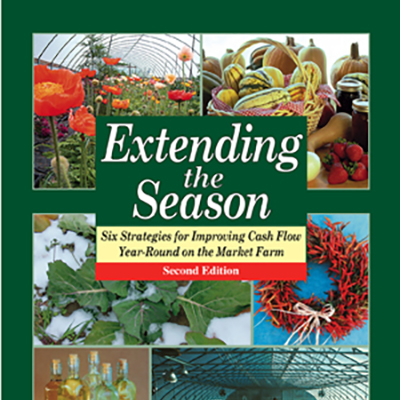




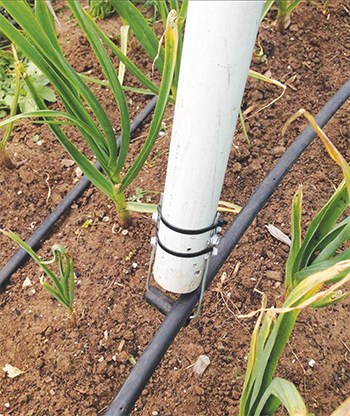 When I saw this tool I knew the exact need that inspired its creation and I loved seeing the abundant comments from other farmers around the world who had also created their own versions, born of that same common need. Nat Wiseman from Village Greens of Willunga Creek near Adelaide in southern Australia posted a very simple and relatively quick fix to the problem of laying drip lines in garlic after the canopy has already filled in.
When I saw this tool I knew the exact need that inspired its creation and I loved seeing the abundant comments from other farmers around the world who had also created their own versions, born of that same common need. Nat Wiseman from Village Greens of Willunga Creek near Adelaide in southern Australia posted a very simple and relatively quick fix to the problem of laying drip lines in garlic after the canopy has already filled in.


 Since it’s the beginning of the year I’m sure lots of you are just about to start filling your greenhouses back up with seedlings in flats, plug trays, soil blocks and nursery pots, just as I am. If you’re not already using automatic water in your greenhouse, I’d encourage you to go check the archives for “Water Greenhouse Plants Automatically” that ran in the January 2010 issue, and I’ll give an update here on the evolution of my greenhouse sprinkler system, and what I’ve ultimately been using for at least the last eight years with good success and next to no problems.
Since it’s the beginning of the year I’m sure lots of you are just about to start filling your greenhouses back up with seedlings in flats, plug trays, soil blocks and nursery pots, just as I am. If you’re not already using automatic water in your greenhouse, I’d encourage you to go check the archives for “Water Greenhouse Plants Automatically” that ran in the January 2010 issue, and I’ll give an update here on the evolution of my greenhouse sprinkler system, and what I’ve ultimately been using for at least the last eight years with good success and next to no problems.
 This month’s submission is from Dogpatch Urban Gardens in Iowa and it’s a simple one – a grabber being used to reach Tomahooks obviating the need for a ladder. It’s quite possible that many of you have already thought of this, but I had never seen this before. I love the idea and I don’t even use hooks…but I might after seeing this.
This month’s submission is from Dogpatch Urban Gardens in Iowa and it’s a simple one – a grabber being used to reach Tomahooks obviating the need for a ladder. It’s quite possible that many of you have already thought of this, but I had never seen this before. I love the idea and I don’t even use hooks…but I might after seeing this.
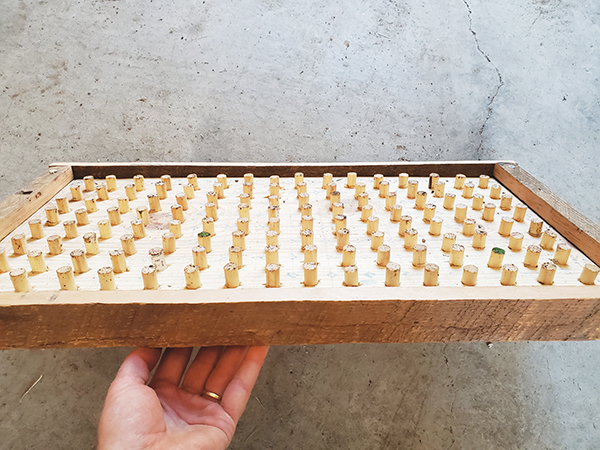 Megan French from Boundless Farmstead near Bend, Oregon, posted these dibblers she built on Instagram and reminded me that I need to get my act together. On their farm they’re typically seeding 30 to 100 trays per week with a vacuum seeder. To get evenly dibbled holes before making the dibbler boards they were using a single bolt with a nut and washer to set the depth. One. Cell. At. A. Time. Which understandably was slow.
Megan French from Boundless Farmstead near Bend, Oregon, posted these dibblers she built on Instagram and reminded me that I need to get my act together. On their farm they’re typically seeding 30 to 100 trays per week with a vacuum seeder. To get evenly dibbled holes before making the dibbler boards they were using a single bolt with a nut and washer to set the depth. One. Cell. At. A. Time. Which understandably was slow.
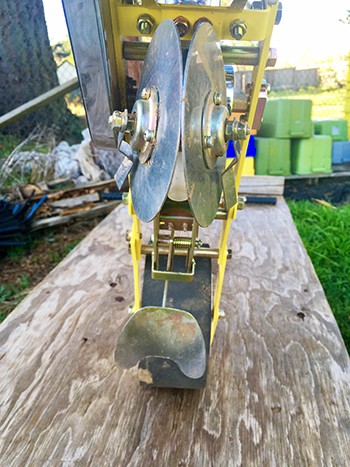 We’re very excited to tell you about a new feature in GFM. As farmers you are out there jury-rigging, farm-hacking, adapting and making new tools. We want to ask you to post or send photos of your tool and equipment ideas that would be useful to fellow farmers.
We’re very excited to tell you about a new feature in GFM. As farmers you are out there jury-rigging, farm-hacking, adapting and making new tools. We want to ask you to post or send photos of your tool and equipment ideas that would be useful to fellow farmers.
 By passion and necessity, farmers are natural innovators. The consolidation in agriculture has led to manufacturers focusing on larger scale tools and equipment, leaving smaller and mid-scale farmers to tinker and “farm hack” old tools to make things work for new systems. Sometimes these projects come together perfectly; as we use welders, carpentry, and possibly too much duct tape (or used greenhouse plastic, used drip tape, etc.) to create the odd looking but highly functional tool.
By passion and necessity, farmers are natural innovators. The consolidation in agriculture has led to manufacturers focusing on larger scale tools and equipment, leaving smaller and mid-scale farmers to tinker and “farm hack” old tools to make things work for new systems. Sometimes these projects come together perfectly; as we use welders, carpentry, and possibly too much duct tape (or used greenhouse plastic, used drip tape, etc.) to create the odd looking but highly functional tool. 